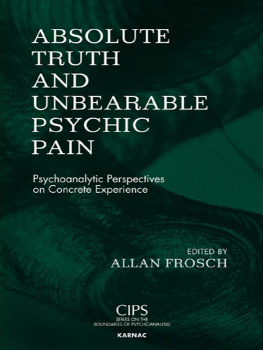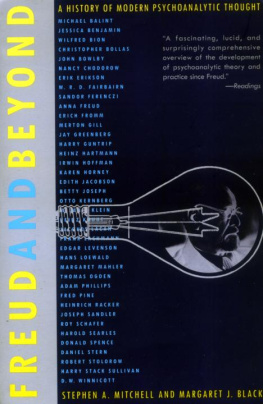Thoughts and Things
Leo Bersani
Thoughts and Things
The University of Chicago Press
Chicago and London
Leo Bersani is professor emeritus of French at the University of California, Berkeley. He is the author of numerous books, including Is the Rectum a Grave? and Other Essays, published by the University of Chicago Press.
The University of Chicago Press, Chicago 60637
The University of Chicago Press, Ltd., London
2015 by The University of Chicago
All rights reserved. Published 2015.
Printed in the United States of America
24 23 22 21 20 19 18 17 16 15 1 2 3 4 5
ISBN-13: 978-0-226-20605-9(cloth)
ISBN-13: 978-0-226-20619-6(e-book)
DOI: 10.7208/chicago/9780226206196.001.0001
Library of Congress Cataloging-in-Publication Data
Bersani, Leo, author.
Thoughts and Things / Leo Bersani.
pagescm
Includes index.
ISBN 978-0-226-20605-9 (cloth : alk. paper)
ISBN 978-0-226-20619-6 (e-book) 1. Ontology.
2. Thought and thinking. 3. Self. I. Title.
bd331.b475 2015
110dc232014019942
This paper meets the requirements of ANSI / NISO Z39.481992 (Permanence of Paper).
Contents
A preface frequently saves us from the labor of reading the book it introduces. Perhaps not exactly from reading the book (although a really good preface can even do that), but from the work, what can be the pain of reading. Because a preface is customarily written after the rest of the book has been completed, it has a unique relation to the textual body for which it prepares us. It knows what we are letting ourselves in for, and it genially (if for the most part laboriously) cushions the shock.
This is the function assigned to prefaces by those institutions most fully and most proudly committed to what is revered as the life of the mind. Thus thousands of Ph.D. candidates are advised (directed) to prepare, as their final piece of work in the doctoral process, a short discussion of what their dissertation is about. (Would that students could afford the luxury of an exasperated refusal to heed that request!a luxury enjoyed and suffered by Jerzy, the director of the film being made within Jean-Luc Godards film Passion, through whom Godard warns us not to hound him about the sense of this film about the making of a film.)
We have all experienced the dreary relief of knowing in advance what awaits us in the I will show of our prefaces is a promissory transformation of I have done.
Is the preface as I have just described it a genre unto itself? Not exactly: if it belongs to a category of writing practiced elsewhere, it is that of the notoriously tedious book report by whichat least in the secondary schools of yesteryear (that is, during my high school years)students were expected to prove that they had read the assigned texts. The book report was not invented as an early experience in critical writing; rather, it was meant to be an accurate summary, a confirmation that the student had both done the homework and gotten it right. Happily, a large number of author-written prefaces fail to pass this test, to fulfill the function of smoothing the path for desired readers, of guaranteeing that their reading experience will not be plagued by questions, objections, and failures to understand.
As the wise editor surely knows, it is more difficult to get oneself right than to think we understand somebody else. In those long-past book reports, we knew the other only as one written volume. In the case of a text I myself have written, how can I not be aware of at least some of the smothered objections I had in the process of writing, as well as of what has been eliminated in heavily (and perhaps unfortunately) revised passagesand even of other things Ive written that may be inconsistent with, or contradict, the text Im introducing? My long history as (to invoke Descartes) both a thinking and a writing thing risks making obscure my attempted summary of one moment of that history. Will I be making myself more accessible through this condensed recapitulation of what I have just written, or will I unintentionally be revealing a certain ignorance of what I was doing in the text Im trying to present, and thereby providing the outline for anotherrevised, correctedtext not yet written? In short, am I increasing the readability of the work already written, or am I running the riskhowever earnestly I have set out to do the oppositeof making not only the textual body but also the introduction to it problematic, even somewhat unreadable?
Of course, good editors know all this, and in asking their writers to provide their texts with prefaces, they may (we can never know how complicated they are) secretly be inviting them to make their books more interestingly opaque rather than more boringly transparent. For example, in agreeing to add a conventional preface to Thoughts and Things, I suppose I would say that all the essays in this bookmost of which were not written as part of a single book projecttreat the question of connectedness: of how the human subject connects or fails to connect to other human subjects and to the nonhuman world.
As part of my effort to convince readers that the different parts of my work do belong together in a single book, I might suggest that they begin by reading , where the relational motif is most fully elaborated conceptually. My argument there is that a major current in Western thought has emphasized the disjunction between the self and the world. A Cartesian assumption of the ontological gap separating res cogitans from res extensa may account for what both Michel Foucault and Richard Rorty, in different contexts, have emphasized as the prioritizing of knowledge in modern thought as the dominant relational mode of the human subjects being-in-the-world. Thinkers as different as Descartes, Freud, and Proust have accustomed us to thinking of our connection to otherness in terms of epistemological appropriation and possession.
ends with a brief invocation of philosophers (from Spinoza to Merleau-Ponty) who, within what Foucault thought of as the hegemony of Cartesian thought in modern Western culture, have elaborated the modes of our connectedness to external reality, of a productively relational rather than intrinsically oppositional presence in the world.
In saying all this, I am perhaps letting myself be carried away by something like the essence of The Preface, an essence whose power I set out to resist. However, having reduced myself to a principal idea or theme, I have come to see how these essays, not having originally been written as chapters of single book, are in fact connected. And not just because they are all about connectedness: they have a complex structural connectedness that is analogous to but richer than their thematic connections. The first two chapters, most notably, are actually domesticated by the ideas developed (you might say thematized) in the chapter that follows them. The great power of Claire Deniss film Beau travail (discussed in ) is that it existentializes not only the oppositional violence that both connects and tears apart a human subject and the world he or she inhabits, but also a certain at-homeness in the world that exists alongside that violence. Alongside is crucial: the sociality beautifully embodied in the Legionnaires is not exactly resistant to the violence embodied in their superior, Galoup. It is, interestingly, juxtaposed with it, as if it could be an alternative to Galoup only if it implicitly recognized its inability to do away with his world of conflict. There may be a mode of sociality that is neither complicitous nor oppositional in its relation to intractable violence, a sociality that acknowledges a violence to which, however, it is constitutively devoid of any relation.
The removal from an oppressive mode of connectedness is even more radically exemplified in the works I discuss in identity wavers at moments when a distraught Divine finds herself floating in an undefined, ungendered territory between male and female. And for Carol in Todd Hayness film
Next page







